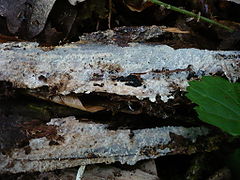| Resinicium | |
|---|---|
 | |
| Resinicium bicolor | |
| Scientific classification | |
| Kingdom: | |
| Division: | |
| Class: | |
| Order: | |
| Family: | |
| Genus: | Resinicium Parmasto (1968) |
| Type species | |
| Resinicium bicolor | |
Resinicium is a genus of crust fungi of uncertain placement in the class Agaricomycetes. The genus was circumscribed by Estonian mycologist Erast Parmasto in 1968. [1]